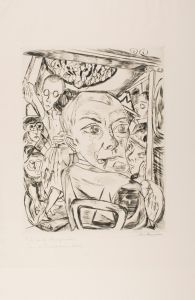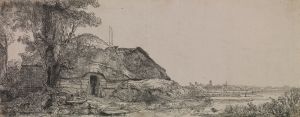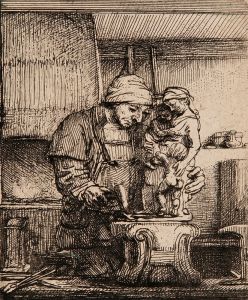
Self-Portrait
A hand-painted replica of Rembrandt van Rijn’s masterpiece Self-Portrait, meticulously crafted by professional artists to capture the true essence of the original. Each piece is created with museum-quality canvas and rare mineral pigments, carefully painted by experienced artists with delicate brushstrokes and rich, layered colors to perfectly recreate the texture of the original artwork. Unlike machine-printed reproductions, this hand-painted version brings the painting to life, infused with the artist’s emotions and skill in every stroke. Whether for personal collection or home decoration, it instantly elevates the artistic atmosphere of any space.
Rembrandt van Rijn, one of the most celebrated artists of the Dutch Golden Age, is renowned for his masterful self-portraits, which provide a profound insight into his life and artistic evolution. Among these, "Self-Portrait" by Rembrandt is a significant work that exemplifies his skill in capturing the human condition and his own visage with remarkable depth and realism.
Rembrandt created numerous self-portraits throughout his career, with estimates ranging from 40 to over 90, including paintings, drawings, and etchings. These works span his entire career, offering a visual autobiography that traces his development as an artist and his personal experiences. The self-portraits are not only a testament to his technical prowess but also serve as a window into his soul, reflecting his introspection and the passage of time.
One of the most notable aspects of Rembrandt's self-portraits is his ability to convey a wide range of emotions and states of mind. He often depicted himself in various guises and expressions, from confident and assertive to contemplative and somber. This versatility is evident in the way he manipulated light and shadow, a technique known as chiaroscuro, to create dramatic contrasts that highlight the contours of his face and the intensity of his gaze.
Rembrandt's self-portraits are also remarkable for their honesty and lack of idealization. Unlike many of his contemporaries, who often portrayed themselves in a flattering light, Rembrandt was unafraid to show the signs of aging and the hardships he endured. This authenticity is particularly evident in his later self-portraits, where the lines and wrinkles on his face tell a story of a life filled with both triumphs and tribulations.
The self-portraits also reflect Rembrandt's experimentation with different styles and techniques. Early in his career, his self-portraits were characterized by a smooth and detailed finish, while later works exhibit a looser, more expressive brushwork. This evolution mirrors the broader trends in his oeuvre, as he moved from the meticulous precision of his early years to the more emotive and textured style of his later period.
One of the most famous self-portraits by Rembrandt is housed in the Mauritshuis in The Hague, painted in 1669, the year of his death. This work is often cited as a poignant example of his late style, showcasing his mastery of light and shadow and his unflinching self-examination. In this painting, Rembrandt presents himself with a direct gaze, wearing a simple cap and cloak, his face illuminated against a dark background. The painting exudes a sense of dignity and introspection, capturing the essence of an artist who has lived a full and complex life.
Rembrandt's self-portraits have had a lasting impact on the art world, influencing countless artists and continuing to captivate audiences with their timeless appeal. They offer not only a glimpse into the artist's personal journey but also a broader reflection on the human experience, making them enduring masterpieces in the history of art.


















